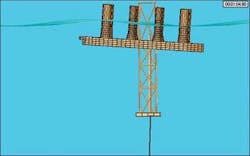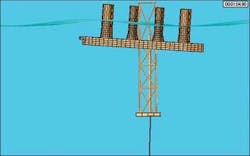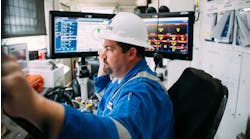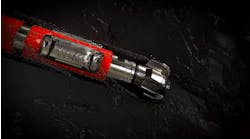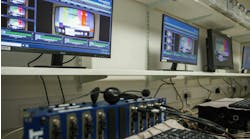Pendulum riser tower improves stability of dry-tree floaters
Wave tests confirm numerical models
null
Jean-Francois Demoulins, D2M
Engineering consultants D2M are continuing their campaign of studies to improve riser/floater interaction for both mild and harsh environments. Their latest concept, the pendulum riser tower (PRT), is designed to facilitate use of buoyancy-tensioned dry tree risers with semisubmersible platforms. Currently spars and TLPs are the only floating installations suited to this configuration, which greatly improves well access and maintenance.
Until now, the motion characteristics of semis have ruled out use of top-tensioned risers owing to stroke problems in the tensioning systems. One of the generally accepted solutions is to limit the motion of the floater.
Last year, D2M introduced a new design of semisubmersible, which features reduced motions that compare favorably to those of a spar.
The new PRT concept lessens substantially the problem of interaction between the risers and the guiding system for the buoyancy cans. It is designed to suppress the need for keel joints on risers at the interface with the guiding structure, at the same time maintaining a low level of fatigue stress at this sensitive point.
Modular structure
The buoyancy can system is an alternative solution for tensioning deepwater risers, which require high tensioning loads in excess of 500 tons, leading to high relative strokes between floater and riser with conventional floaters in harsh environments.
Typically, buoyancy cans are subjected to near-surface currents and wave-loading that could not be sustained by risers lacking a guiding system. With spars, this guiding is provided by the spar structure itself, but with the penalty of inducing loads in the risers at the bottom of the structure due to the platform’s angular motion (roll and pitch) and offset. In existing systems, this loading problem is countered via the use of flexible keel joints.
D2M’s concept (right) consists of a modular structure in the form of a truss tower, housing, and guiding a number of dry tree risers (typically 12 to 20-plus) and their tensioning buoyancy cans, with space for wellheads and, if requested, a production manifold. On top of the tower, an installation and workover rig is fitted with skidding capacity to provide access to any well.
A key feature of the design is the fact that the tower structure is pinned at its connection to the main deck of the floating platform. The tower also has built-in top floating cans and bottom ballast. With appropriate design parameters for these flotation/ballast features, the tower behaves as a soft and compliant guide that effectively supports the loads on the upper part of the riser, but also allows the riser to keep a soft deflection without excessive bending.
Analyzing the coupled behavior of a moving floating platform, a hinged structure, and a group of deepwater risers - a complex combination - has involved use of state-of-the-art simulation tools such as AQWA multi-bodies time domain hydrodynamics and Deeplines riser simulation software.
Recently, the concept underwent a model test program at the Oceanide wave test facility in La Seyne-sur-Mer, southern France. A 1/100-scale model with riser and tower mock-up was subjected to a range of environment loadings, including low- and high-frequency platform offsets, and waves and currents in a parametric study in order to validate the concept and qualify the numerical models used for design.
In view of the system’s very attractive behavior, derived from analysis and confirmed in tests, D2M is continuing the development mainly through engineering of the pivot system connecting the tower to the floating platform. This system will be based on a virtual pivot with a passive hydraulic bed (similar in principle to a waterbed), employing conventional hydraulic cylinders for load transfer and elastomer pads for guiding.
This development is being targeted at applications such as semisubmersible production platforms in harsh environments, or barge-type floating production units and FPSOs in less severe climates.
